Sales automation is a great way to drive results — all while saving time and resources. In fact, automation should be a key part of your CRM sales management strategy.
Most deals take around five follow-ups to close. The more leads in your pipeline, the faster you’ll get bogged down in repetitive tasks. This keeps you from closing deals and building lasting customer relationships.
Want to learn more? The article will go over sales automation, examples, and the best tools for your business.
What is sales automation?
Sales automation is the use of technology to streamline and automate repetitive or time-consuming workflows within the sales process.
Automation aims to minimize, or even eliminate, manual tasks. These include data entry, email outreach, and follow-ups. It can also be used for more complex sales tasks like lead scoring and routing.
Benefits of sales automation
Sales automation doesn’t just save time — it actively contributes to your bottom line. And while a sales automation tech stack will require some initial investment of time and money, it will pay off fast. Here’s how.
Faster sales cycles
Automation workflows speed up communication, follow-ups, and the flow of information throughout the sales process. You’ll stay on top of your deals without getting overwhelmed with manual work and close deals faster.
Secondly, sales automation can act like a filter that pinpoints the most promising leads. If you set up advanced lead scoring and analytics, you get data to prioritize your efforts. This will help you focus on those most likely to convert, accelerating the entire process.
Increased sales
For sure, faster sales cycles mean you can close more deals in the same timeframe. But that's not the only way sales automation increases sales.
Automation lets you analyze real-time customer data. It also helps you identify potential upselling and cross-selling opportunities. Additionally, you can set up automated triggers to deliver relevant offers at the perfect moment, maximizing the likelihood of a sale.
Better customer experiences
Automation empowers you to deliver tailored communication and targeted offers at scale. It creates positive customer experiences and fosters long-lasting relationships. These are more valuable than one-time sales.
Data-driven planning
We've explored how sales automation streamlines tasks, but its power extends far beyond that. Another face of automation is forecasting. Most sales automation tools can use deal data to predict revenue. This lets you:
- Set realistic goals based on sales forecasts
- Adapt your strategy if forecasts indicate a potential shortfall
- Make more confident decisions about hiring, training, investing in tools, etc.
Sales automation platforms also provide in-depth analytics about your sales pipeline, conversion rates, and team performance. And the better you’re aligned with your data, the closer you get to achieving your revenue goals.
Reduced errors
Mistakes like incorrect contact information, misspelled names, missing data, or simple forgetfulness are common when you rely on manual data entry. Sales automation reduces the potential for human error.
Further reading: 16 Key Benefits of Marketing Automation
How to automate the sales process
Are you sold on the benefits of sales automation? Then you’ll want to know how you can actually make it happen. Below are the steps to set up your first sales automations.
Map out your process
Before you figure out what and how you should automate, you need a crystal-clear understanding of your current sales process. Ask yourself:
- How do prospects usually move through your sales funnel? While not always linear, there are likely common patterns and stages.
- Does your sales process align with your customer journeys? What does it look like?
- What software or systems do you currently use to manage your sales process (CRM, spreadsheets, etc.)?
It can be helpful to visually map out your customer journey and sales process. Use a simple flowchart or diagram to identify the different stages, milestones, and decision points throughout the funnel.
Prioritize tasks
While it's common advice to start by automating the most repetitive and time-consuming tasks, this approach can cause friction later on.
Your sales process is a chain of consequent events — if you automate a task in the middle, but haven't addressed what comes before, things will get messy. You might end up with mismatched data and awkward handoffs between manual and automated steps.
A more straightforward way to implement sales automation is by starting at the top of the funnel and working your way down. This approach ensures a seamless process for your leads, minimizing the need to rebuild or readjust existing automations as you progress.
Choose the right tools
Luckily, you don't have to be a tech expert to set up and use sales automation. Modern software offers a wide range of solutions for businesses of all sizes, making it easy to build powerful automation workflows.
Especially for smaller businesses, it’s best to choose software with intuitive drag-and-drop functionality.
A huge bonus is finding a tool that combines multiple business functions like CRM, email marketing, and customer service into one. This saves you the hassle of integrations and switching between tools.
Sales automation examples
Here are a few practical sales automation examples to get you started.
Lead management
For many, as soon as a user shares their contact details, the sales process kicks off. This is the perfect starting point to let automation take over.
Lead management is a broad concept. It includes a set of strategies and activities involved in nurturing your relationships with potential customers from the moment they share their contact information until they convert into paying clients.
Here are four key areas within lead management where automation is absolutely essential:
- Lead generation
- Lead nurturing
- Lead scoring
- Lead routing
Let’s look into each in more detail.
Lead generation
To start generating leads, you need a few things: a compelling landing page (that could be your website, social media, or a dedicated campaign page), a sleek lead capture form, and a way to get all that lead data smoothly into your sales system.
Many platforms streamline this process, including Brevo. Here, you can design landing pages, create forms, and manage all your leads within its CRM system.

Creating a signup form using Brevo’s drag-and-drop builder
Further reading: 8 Winning Strategies to Generate Warm Leads
Lead nurturing
Once the lead gets into your funnel, you can start nurturing them immediately. What your campaign looks like depends on the data you collected through your form. If you only have a name and email address, your next steps should focus on uncovering their specific needs.
You can start with a generic welcome sequence, a discount offer, a demo invite, or any other message that might pique their interest. The best part: you can automate the entire process.
A simple welcome workflow example will look like this:
- Entry point: a new lead gets to your CRM system
- Condition: wait for 5 minutes
- Action: send the welcome email sequence
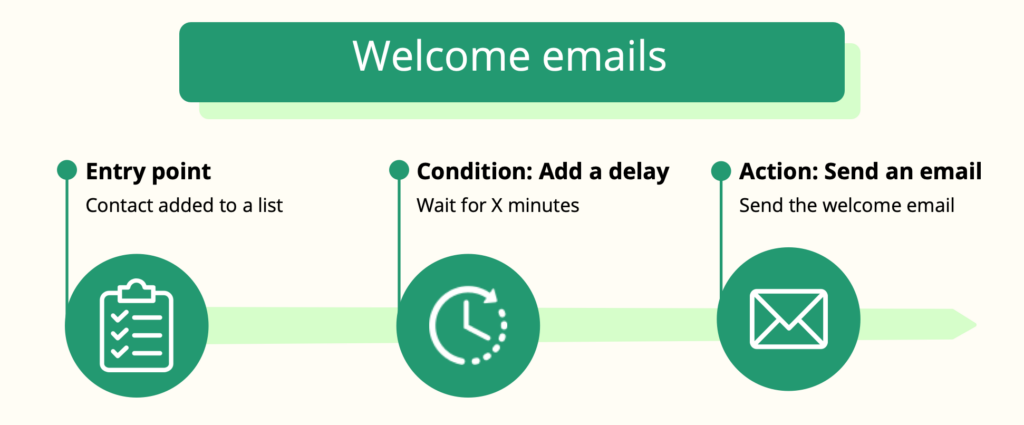
Setting up automated welcome emails with Brevo
Lead scoring
What happens after you’ve sent your welcome email? While it depends on the campaign, these are signs of positive engagement: 1) clicking on your email and 2) visiting your site from the email content.
This is where lead scoring comes in. You can use this data to automatically score your leads and add them to a more targeted contact list for personalized nurturing.
Good news: you don't have to manually track email engagement or calculate scores for each individual lead. Your sales automation platform can do it for you.
First, you’ll need to define the following:
- Expected outcomes: What actions indicate a lead is engaged (email opens, website visits, content downloads, etc.)?
- Scores: How much value do you assign to each type of engagement?
- Next actions: At what score does a lead get added to a specific list, receive a particular type of communication, or get assigned to a specific rep?
After answering those questions, you can build a new workflow or continue the existing one.
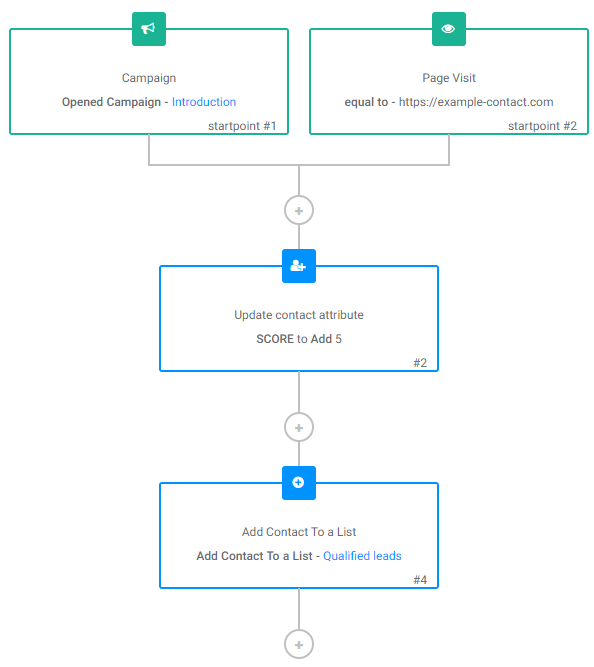
A lead scoring automation workflow in Brevo
Automated deal creation
When a lead is qualified and ready to move forward, this is where the real sales process begins. For some, it may actually be the first touchpoint with the lead (e.g. when the marketing team handles initial lead acquisition and nurturing).
Either way, you need to set up automated deal creation within your sales software. This keeps hot leads from falling through the cracks. It also lets you launch into your targeted sales plan at the perfect moment.
Note: To automatically create deals in Brevo, you need to create a sales pipeline first (or use a default one).
When ready, create a new automation instead of overloading the existing one. This keeps things organized and easy to update later. Give your automation a clear name and description. Make it clear what it does and why.
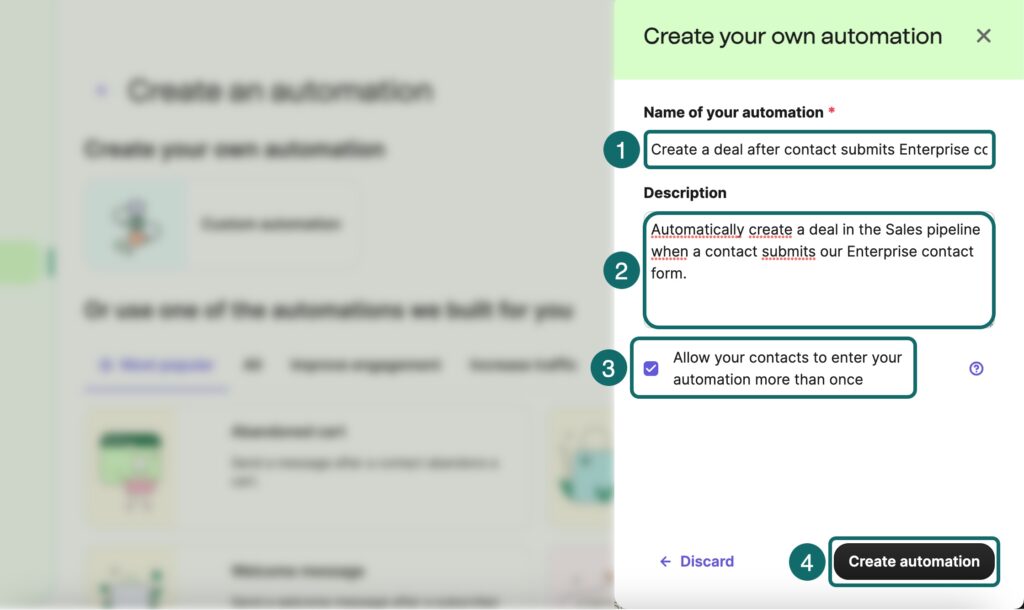
Describing your new automation in Brevo
Next, design your flow: specify the entry point. Click “+” and go to Perform a CRM action > Create a new deal.
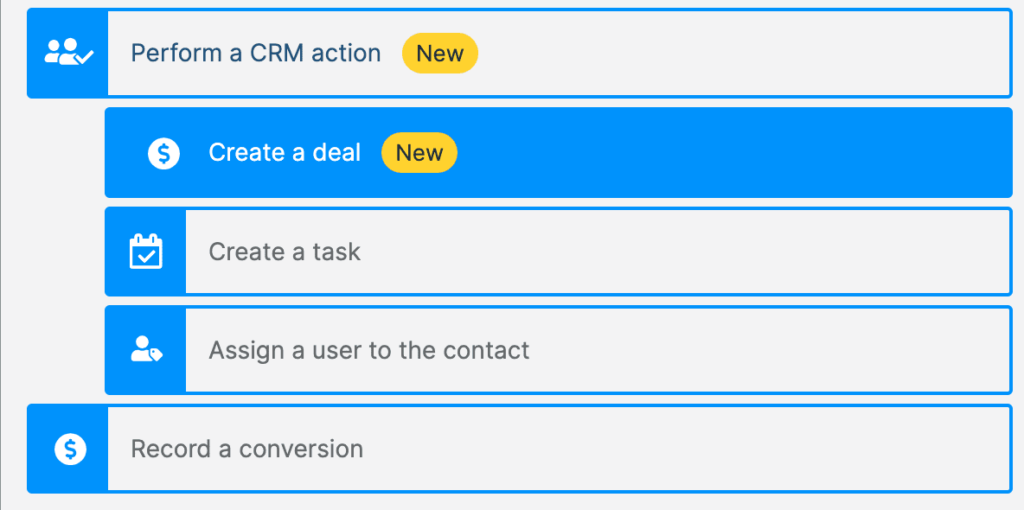
Automatically creating a new deal in Brevo
Give your deal a name, choose the pipeline, and choose a specific stage. The resulting workflow will look like this:
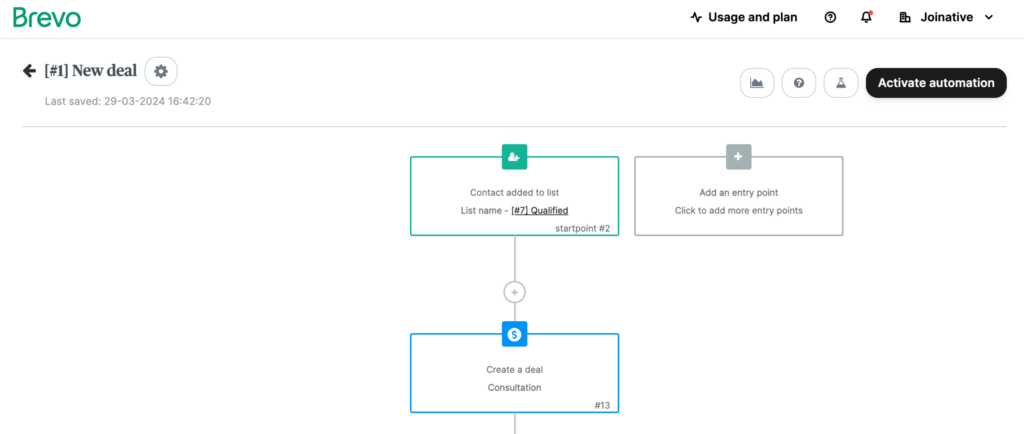
Brevo’s workflow automation builder
Pipeline management
Now, when a contact meets the criteria specified in your workflow, the deal will be created and they’ll get to your pipeline:

Deal pipeline management in Brevo
From here, you may take a ton of different routes. Most often, salespeople take the following actions, all powered by automation:
- Assign a different owner to the contact. You can set up a workflow to re-assign your hot leads to your sales closer.
- Send an automated email to the lead. It can be a personalized email or an offer tailored to the lead's interests.
- Assign a task to a contact/deal owner. Need the right sales rep to follow up on a hot lead immediately? Set up automated reminders.
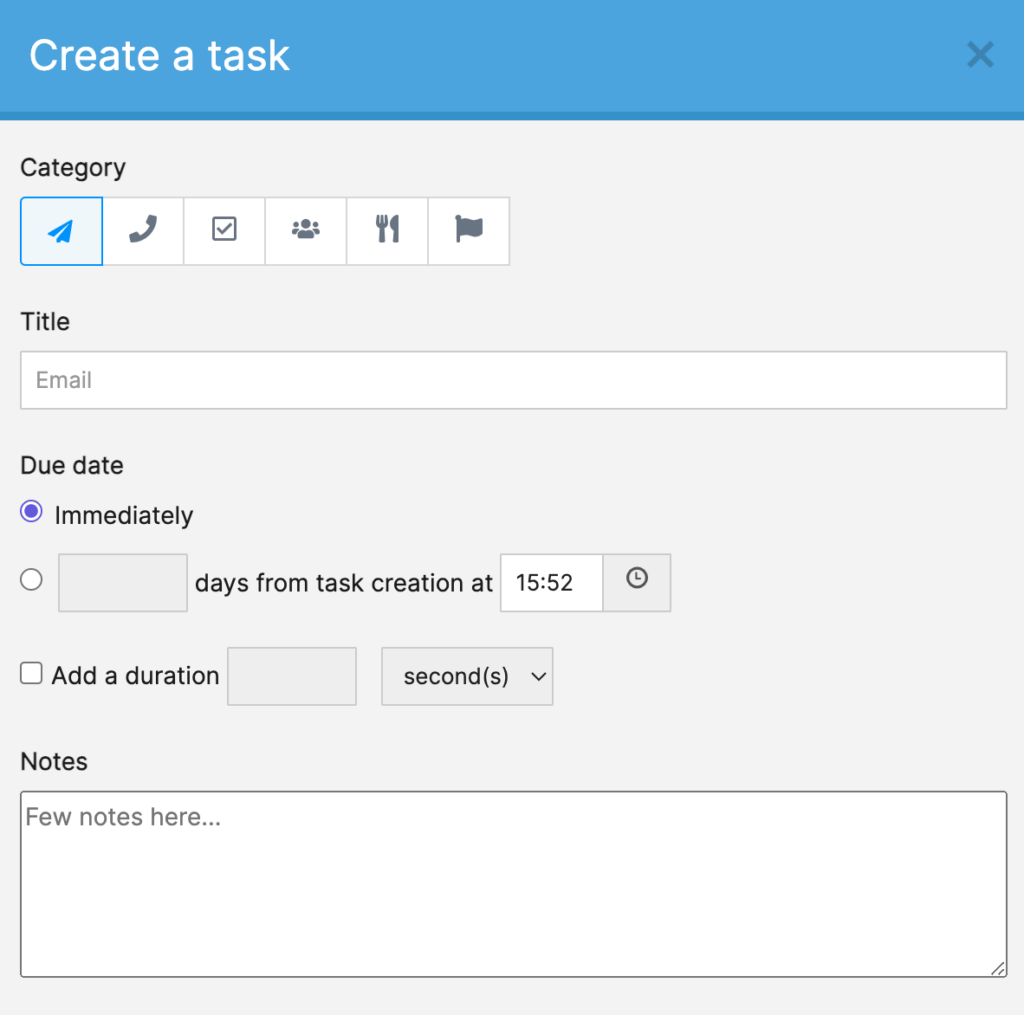
Creating automation to trigger new tasks for your sales reps in Brevo
You can also set up workflows that will fire after you update a deal stage. For example, you may send follow-up emails after demos, stay in touch with the ones you’ve just closed, etc.
Ongoing customer relationship management
The sale isn't the finish line. Use your automation builder to encourage post-purchase engagement and build lasting relationships.
Here are just a few ideas for your next steps:
- Onboarding workflows. Welcome new customers with personalized email campaigns providing resources, tips, and setup guides.
- Upselling/cross-selling campaigns. Use automation to analyze past purchases and behavior. Then send perfectly timed offers for upgrades or complementary products.
- Automated customer surveys. Trigger emails with survey links after key interactions like order pickup or support calls.

An onboarding email example
Sales reporting
You wouldn't go this far without accurate insights into your sales process. And of course, automation helps with that too.
First off, your CRM software (or sales automation platform) should track how leads interact with your website and campaigns. Without this visibility, you're flying blind.
Your software will gather tons of valuable sales data. This includes insights into how contacts interact with your marketing campaigns and website. It might also generate reports on conversion rates, revenue (both actual and forecasted), and team performance.

Team performance insights in Brevo
Further reading: How to Do Sales Forecasting in Excel
3 Best sales automation tools
Not all sales processes look the same. Some focus on inbound lead generation. Some excel at high-volume outreach. And others require complex multichannel strategies.
Here’s the top sales automation software for different use cases.
1. Brevo: Best for marketing and sales automation
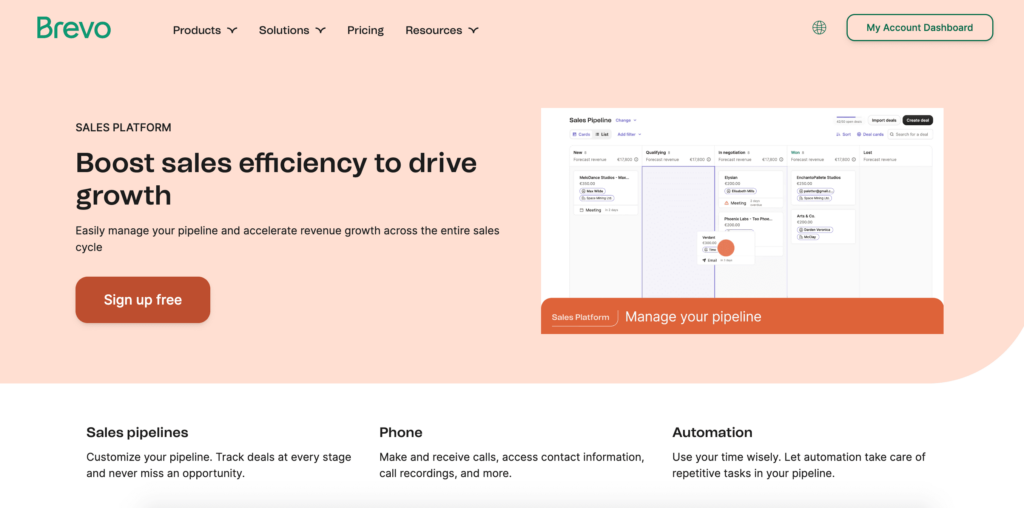
Brevo Sales Platform
Brevo offers a set of sales, marketing, and customer service tools that come under one roof.
It's designed to streamline your entire workflow, from lead capture to closing deals and beyond. Here's why Brevo is a great choice for small businesses and growing sales teams:
- Powerful automation: You can use pre-built templates or design custom workflows to trigger deal creation, send personalized emails, assign tasks, and keep your pipeline flowing smoothly.
- Deal pipeline management: Use a default pipeline or create custom ones to mirror your unique sales process. The drag-and-drop functionality makes it easy to update deal stages and keep your pipeline organized.
- Sales tracking and reporting: Stay on top of your sales performance with Brevo’s sales reports and forecasts.
- All-in-one sales powerhouse: Brevo goes beyond sales automation and tracking. Enjoy built-in video conferencing, a cloud-based phone system, a shared multi-channel inbox, and collaboration features — all designed to empower your team.
- Beyond sales: With Brevo, you also access tools for email marketing, landing pages, forms, and even chatbots, ensuring every part of your customer journey is covered. Most of them are available in one free package.
Brevo's core sales automation tools are available in a free-forever plan. For unlimited pipelines and deals, upgrade to the Pro plan for just $12/user/month.
2. Outreach: Best for outbound sales automation
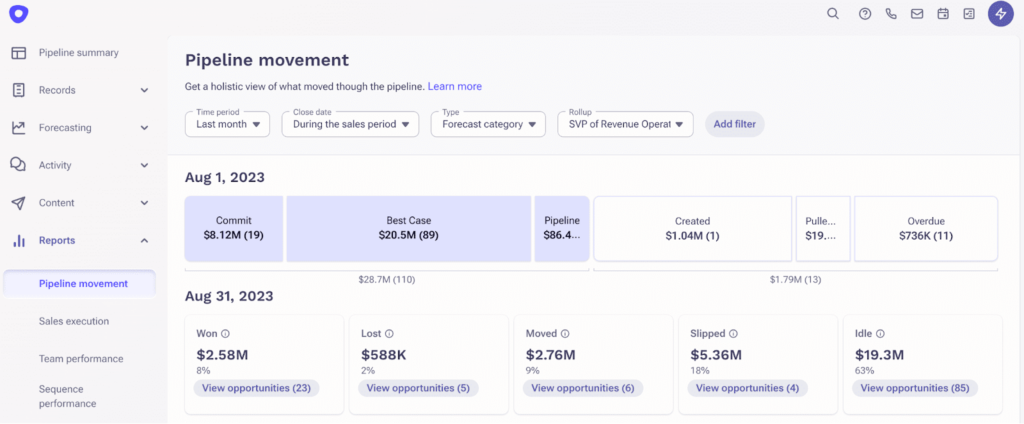
Outreach Sales Execution Platform
Outreach is a sales engagement platform designed to streamline and optimize outbound sales efforts. Its key features include:
- Sales sequences and playbooks
- Sales rep coaching
- Advanced pipeline management and analytics
- Automated sequences and streamlined workflows
- Mutual action plans
- Team and rep performance reporting
- Forecasting
- AI-powered copilot
All of these make Outreach a powerful choice for mid-market and enterprise organizations with complex outbound sales processes.
Outreach stands out with its sophisticated artificial intelligence (AI) capabilities, powering features from deal outcome predictions to personalized message suggestions.
While Outreach doesn't publish pricing upfront, expect plans to start at around $100/user/month.
3. Lemlist: Best for cold email outreach

Lemlist’s automated sales outreach software
Lemlist is a cold outreach automation tool for small businesses. It’s a great option if you rely on outbound sales but don't need the advanced enterprise features offered by platforms like Outreach.
Lemlist arms you with powerful tools to:
- Find the right prospects and their email addresses
- Personalize cold emails
- Automate multi-channel outreach
- Set up LinkedIn automations
- Optimize deliverability
Lemlist starts at just $39/user/month for essential cold outreach tools like email finding, personalization, and task management. The $99/user/month plan unlocks LinkedIn prospecting automation and advanced sequencing features.
Get started with sales automation
Want to get started with sales automation? Try Brevo’s Sales Platform for free.
The intuitive interface makes building sales process automations a breeze. Get access to powerful features that let you nurture leads, automate tasks, and much more.
As your business scales, upgrade to the Pro plan for unlimited deals and pipelines. Pricing starts at $12/month.







